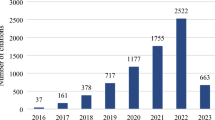Abstract
In this present era, real-life problems are profoundly nonlinear and multi-objective. These objectives are usually clashing with one another and their solutions are not unique. Numerous techniques have been accommodated in finding optimal solutions to these problems. However, the present paper deciphers to solve multi-objective signomial programming problems by consolidating \(\epsilon \)-constraint method with the geometric programming (GP) technique. The GP technique is used to address posynomial (problems with positive coefficients) nonlinear programming problems whereas signomial programming is a generalization of geometric programming in which the coefficients are not necessarily positive. This technique can be used in several fields of engineering analysis, aircraft design, finance, etc. A numerical example of a multi-objective signomial programming problem is stated to prove the proposed technique.
Similar content being viewed by others
Data Availability
Enquiries about data availability should be directed to the authors.
Code Availability
Software used- Lingo.
References
Aliabadi, L., Yazdanparast, R., Nasiri, M.M.: An inventory model for non-instantaneous deteriorating items with credit period and carbon emission sensitive demand: a signomial geometric programming approach. Int. J. Manag. Sci. Eng. Manag. 14(2), 124–136 (2019)
Beightler, C.S., Phillips, D.T., Wilde, D.J.: Foundations of Optimization. Prentice-Hall, New Jersy (1979)
Biswal, M.P.: Fuzzy Programming technique to solve multi-objective geometric programming problem. Fuzzy Sets Syst. 51, 67–71 (1992)
Bjork, K.M., Lindberg, P.O., Westerlund, T.: Some convexifications in global optimization of problems containing signomial terms. Comput. Chem. Eng. 27, 669–679 (2003)
Bjork, K.M., Westerlund, T.: A class of transformations convexifying and underestimating negative signomial terms, Report 02-182- A, Process Design Laboratory at Abo Akademi University, Finland, ISBN 952-12-0968-2 (2002)
Boyd, S.J., Vandenberghe, L., Hossib, A.: A tutorial on geometric programming. Optim. Eng. 8(1), 67–127 (2007)
Cao, B.Y.: Solution and theory of question for a kind of fuzzy geometric program. In: Proceedings of 2nd IFSA Congress, Tokyo, vol. 1, pp. 205–208 (1987)
Cao, B.Y.: Fuzzy geometric programming(1). Fuzzy Sets Syst. 53(2), 135–153 (1993)
Dahmani, N., Krichen, S., Talbi, E.G., Kaddoura, S.: Solving the multi-objective 2-dimensional vector packing problem using \(\epsilon \)-constraint method, Trends and Applications in Information Systems and Technologies, Advances in Intelligent Systems and Computing book series (AISC,volume 1368), pp. 96-104 (2021)
Dowdle, A.P., Hall, D.K., Lang, J.H.: Electric Propulsion Architecture Assessment via Signomial Programming, AIAA/IEEE Electric Aircraft Technologies Symposium (EATS), July 9–11. Cincinnati, Ohio (2018)
Duffin, R.J., Peterson, E.L., Zener, C.M.: Geometric Programming Theory and Application. Wiley, New York (1967)
Duffin, R.J., Peterson, E.L.: Geometric programing with signomials, geometric programing with signomials. J. Optim. Theory Appl. 11, 3–35 (1973)
Haimes, Y., Lasdon, L., Wismer, D.: On a bicriterion formulation of the problems of integrated system identification and system optimization. IEEE Trans. Syst. Man Cybern. 1, 296–297 (1971)
Kirschen, G.P., York, M.A., Ozturk, B., Hoburg, W.W.: Application of signomial programming to aircraft design. J. Aircr. 55(3), 1–23 (2017)
Mandal, W.A., Islam, S.: Modified signomial geometric programming (MSGP) and its Applications. Independent J. Manag. Prod. (IJMP) 10(2), 440–458 (2014)
Mehrotra, S.: On the Implementation of a Primal-Dual Interior Point Method. SIAM J. Optim. 2(4), 575–601 (1992). https://doi.org/10.1137/0802028
Murray, R., Chandrasekaran, V., Wierman, A.: Signomial and polynomial optimization via relative entropy and partial dualization. Math. Program. Comput. 13, 297–299 (2021)
Ojha, A.K., Ota, R.R.: A hybrid method for solving multi-objective geometric programming problem. Int. J. Math. Oper. Res. 7(2), 119–137 (2015)
Peterson, E.L.: The fundamental relations between geometric programming duality, Parametric programming duality, and ordinary Lagrangian duality. Ann. Oper. Res. 105, 109–153 (2001)
Porn, R., Harjunkoski, I., Westerlund, T.: Convexification of different classes of non-convex MINLP problems. Comput. Chem. Eng. 23, 439–448 (1999)
Rajgopal, J., Bricker, D.L.: Solving Posynomial geometric programming problems via generalised linear programming. Comput. Optim. Appl. 21, 95–109 (2002)
Roy, S.K., Midya, S., Yu, V.F.: Multi-objective fixed-charge Transportation problem with Random Rough Variables. Int. J. Uncertain. Fuzziness Knowl. Based Syst. 26(06), 971–996 (2018)
Tsai, J.F., Lin, M.H.: Global optimization of signomial mixed integer nonlinear programming problems with free variables. J. Glob. Optim. 42, 39–49 (2008). https://doi.org/10.1007/s10898-007-9211-8
Westerlund, T., Bjork, K.M.: A class of transformations convexifying and underestimating positive signomial terms, Report 02-183-A, Process Design Laboratory at Abo Akademi University, Finland, ISBN 952-12-1018-4 (2002)
Funding
The authors have not disclosed any funding.
Author information
Authors and Affiliations
Contributions
Both authors tried to solve “An efficient method for solving multi objective signomial programming problems in real life” with help of Lingo software and studied the importance.
Corresponding author
Ethics declarations
Conflict of interest
On behalf of all authors, I am declaring that there is no conflict of interest with us.
Additional information
Publisher's Note
Springer Nature remains neutral with regard to jurisdictional claims in published maps and institutional affiliations.
Rights and permissions
Springer Nature or its licensor holds exclusive rights to this article under a publishing agreement with the author(s) or other rightsholder(s); author self-archiving of the accepted manuscript version of this article is solely governed by the terms of such publishing agreement and applicable law.
About this article
Cite this article
Mishra, S., Ota, R.R. An Efficient Method for Solving Multi-Objective Signomial Programming Problems in Real Life. Int. J. Appl. Comput. Math 8, 204 (2022). https://doi.org/10.1007/s40819-022-01416-z
Accepted:
Published:
DOI: https://doi.org/10.1007/s40819-022-01416-z




